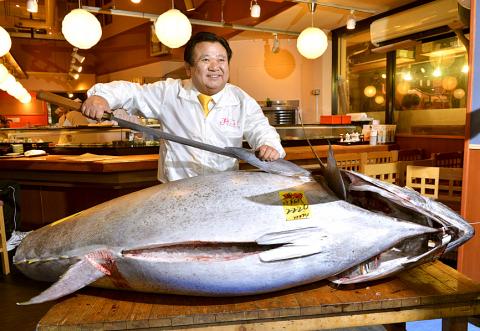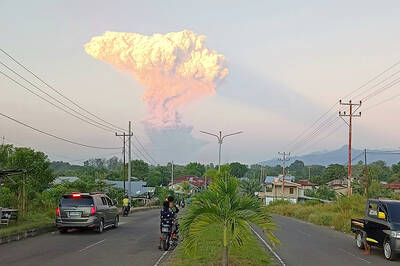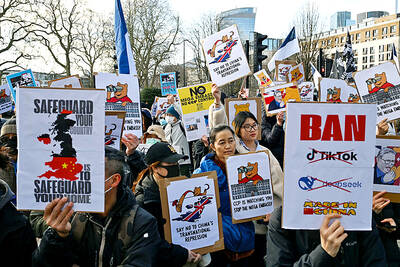A bluefin tuna sold for a record US$1.76 million at a Tokyo auction yesterday, nearly three times the previous high set last year — even as environmentalists warn that stocks of the majestic, speedy fish are being depleted worldwide amid strong demand for sushi.
In the year’s first auction at Tokyo’s sprawling Tsukiji fish market, the 222kg tuna caught off northeastern Japan sold for ¥155.4 million, said Ryoji Yagi, a market official.
The fish’s tender pink and red meat is prized for sushi and sashimi. The best slices of fatty bluefin — called otoro — can sell for ¥2,000 per piece at upmarket Tokyo sushi bars.

Photo: AFP
Japanese eat 80 percent of the bluefin tuna caught worldwide and much of the global catch is shipped to Japan for consumption.
The winning bidder, Kiyoshi Kimura, president of Kiyomura Co, which operates the Sushi-Zanmai restaurant chain, said “the price was a bit high,” but that he wanted to “encourage Japan,” according to Kyodo News agency.
He was planning to serve the fish to customers later yesterday.
Kimura also set the old record of ¥56.4 million at last year’s new year’s auction, which tends to attract high bids as a celebratory way to ring in the new year — or get some publicity.
The high prices do not necessarily reflect exceptionally high fish quality.
The price works out to ¥700,000 per kilogram.
Stocks of all three bluefin species — the Pacific, Southern and Atlantic — have fallen over the past 15 years amid overfishing.
Tomorrow, an intergovernmental group is to release data on Pacific Bluefin stocks that environmentalists believe will likely show an alarming decline.
“Everything we’re hearing is that there’s no good news for the Pacific Bluefin,” said Amanda Nickson, the director of the Washington-based Pew Environmental Group’s global tuna conservation campaign. “We’re seeing a very high value fish continue to be overfished.”
The population of another species, the Southern Bluefin, which swims in the southern Pacific, has plunged to 3-8 percent of its original levels.
Stocks of bluefin caught in the Atlantic and Mediterranean plunged by 60 percent between 1997 and 2007 due to rampant, often illegal, overfishing and lax quotas. Although there has been some improvement in recent years, experts say the outlook for the species is still fragile.
In November, the 48 member nations of the International Commission for the Conservation of Atlantic Tunas voted to maintain strict catch limits on the species, although some countries argued for higher limits.
The quota will be allowed to rise slightly from 12,900 tonnes a year to 13,500 tonnes. Quotas were as high as 32,000 tonnes in 2006.
A total catch limit on the Pacific Bluefin has been imposed only recently in the eastern part of the Pacific near the US and Mexico, but not by the intergovernmental group that oversees the western Pacific, Nickson said.

BOMBARDMENT: Moscow sent more than 440 drones and 32 missiles, Volodymyr Zelenskiy said, in ‘one of the most terrifying strikes’ on the capital in recent months A nighttime Russian missile and drone bombardment of Ukraine killed at least 15 people and injured 116 while they slept in their homes, local officials said yesterday, with the main barrage centering on the capital, Kyiv. Kyiv City Military Administration head Tymur Tkachenko said 14 people were killed and 99 were injured as explosions echoed across the city for hours during the night. The bombardment demolished a nine-story residential building, destroying dozens of apartments. Emergency workers were at the scene to rescue people from under the rubble. Russia flung more than 440 drones and 32 missiles at Ukraine, Ukrainian President Volodymyr Zelenskiy

‘SHORTSIGHTED’: Using aid as leverage is punitive, would not be regarded well among Pacific Island nations and would further open the door for China, an academic said New Zealand has suspended millions of dollars in budget funding to the Cook Islands, it said yesterday, as the relationship between the two constitutionally linked countries continues to deteriorate amid the island group’s deepening ties with China. A spokesperson for New Zealand Minister of Foreign Affairs Winston Peters said in a statement that New Zealand early this month decided to suspend payment of NZ$18.2 million (US$11 million) in core sector support funding for this year and next year as it “relies on a high trust bilateral relationship.” New Zealand and Australia have become increasingly cautious about China’s growing presence in the Pacific

Indonesia’s Mount Lewotobi Laki-Laki yesterday erupted again with giant ash and smoke plumes after forcing evacuations of villages and flight cancelations, including to and from the resort island of Bali. Several eruptions sent ash up to 5km into the sky on Tuesday evening to yesterday afternoon. An eruption on Tuesday afternoon sent thick, gray clouds 10km into the sky that expanded into a mushroom-shaped ash cloud visible as much as 150km kilometers away. The eruption alert was raised on Tuesday to the highest level and the danger zone where people are recommended to leave was expanded to 8km from the crater. Officers also

ESPIONAGE: The British government’s decision on the proposed embassy hinges on the security of underground data cables, a former diplomat has said A US intervention over China’s proposed new embassy in London has thrown a potential resolution “up in the air,” campaigners have said, amid concerns over the site’s proximity to a sensitive hub of critical communication cables. The furor over a new “super-embassy” on the edge of London’s financial district was reignited last week when the White House said it was “deeply concerned” over potential Chinese access to “the sensitive communications of one of our closest allies.” The Dutch parliament has also raised concerns about Beijing’s ideal location of Royal Mint Court, on the edge of the City of London, which has so